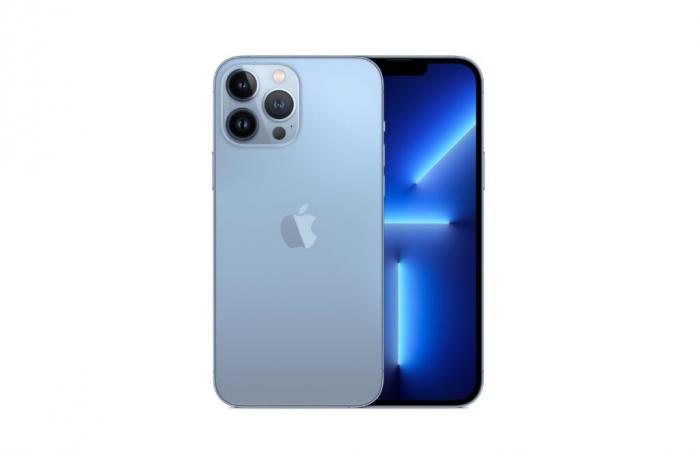The three iPhone models share design elements characteristic of the brand, with a square arrangement of the photo sensors in the upper left corner of the rear of the devices. On the iPhone 16 and iPhone 15, both sensors are integrated in this typical configuration, while the iPhone 13 Pro Max integrates three sensors in the same arrangement, giving it a more sophisticated look on the back. All feature an aluminum profile, with various colors. The iPhone 16 comes in black, white, pink, green, and blue, the iPhone 15 has pink, yellow, green, blue, and black options, and the iPhone 13 Pro Max comes in black, purple, silver and gold.
In terms of dimensions, the iPhone 13 Pro Max is the largest and heaviest, with a height of 160.8 mm and a weight of 240 grams, making it a suitable model for people looking for a wide screen. The iPhone 15 and 16 share smaller measurements than the Pro Max version and weigh 171 and 170 grams respectively, making them lighter and more compact models. In terms of waterproofing, all three models benefit from IP68 certification, guaranteeing resistance to water and dust, an asset for those who want a certain robustness.
Which is the most powerful and which is the best screen?
The performance of these iPhones differs depending on their processors and RAM. The iPhone 16 is equipped with the Apple A18 chip and 8GB of RAM, a duo that makes it the most powerful of the three models, providing high processing capacity for the most demanding applications. The iPhone 15, with its A16 processor and 6 GB of RAM, is just below, remaining very efficient for intensive use.
As for the iPhone 13 Pro Max, it is powered by the A15 Bionic also with 6 GB of RAM, which, although a little behind, still makes it efficient for the majority of daily uses. None of these models allow storage expansion via micro SD, but they offer different internal capacities ranging from 128 GB up to 1 TB for the iPhone 15 and iPhone 13 Pro Max, and up to 512 GB for the iPhone 16.
Regarding the screens, all models are equipped with AMOLED panels, offering rich colors and high contrast. The iPhone 13 Pro Max has the largest screen, with a diagonal of 6.7 inches and a definition of 1284 x 2778 pixels. The iPhone 16 and 15 have 6.1-inch screens with a definition of 1179 x 2556 pixels. The screen refresh rate is 120Hz for the iPhone 16 and 13 Pro Max, providing a smooth experience, while the iPhone 15 remains limited to 60Hz, which can be felt in the responsiveness of the screen. ‘display.
The three models reach a peak brightness of 2000 cd/m², allowing pleasant visibility in direct sunlight. For fans of visual fluidity, the iPhone 16 and 13 Pro Max stand out thanks to their high refresh rate.
What configurations for photos and what connectivity?
When it comes to photography, each model has varied sensors to meet different uses. The iPhone 16 and 15 share a similar setup with a 48-megapixel, optically stabilized main sensor and a 12-megapixel telephoto lens with 2x optical zoom. The selfie sensor is 12 megapixels on all three models. The iPhone 13 Pro Max, for its part, stands out for the presence of a third 12-megapixel ultra-wide-angle sensor, ideal for wide shots. For users keen on photography, the iPhone 13 Pro Max might be the most comprehensive, with varied options for different types of shots, although the iPhone 16’s sensors offer better resolution.
For connectivity, all three models are compatible with 5G and have NFC technology. The iPhone 16 and 13 Pro Max offer Wi-Fi 6E, providing faster connection speeds, while the iPhone 15 remains on Wi-Fi 6. None of the models come with a jack, but all have Bluetooth built-in 5.3. Finally, the fingerprint reader is absent from these three models, favoring facial recognition for unlocking.
What about autonomy and charging capabilities?
Battery capacity is another essential criterion. The iPhone 13 Pro Max has the largest battery at 4,352 mAh, which could give it longer battery life, although this will vary depending on usage. The iPhone 15 has a slightly larger battery than the iPhone 16, with 3349 mAh compared to 3274 mAh. Regarding charging, the iPhone 16 supports a charging power of 30 watts, allowing fast charging, as well as wireless charging at up to 25 watts and reverse charging at 7.5 watts. The iPhone 15’s charging capabilities are unspecified but also include wireless and reverse charging. The iPhone 13 Pro Max supports wireless and reverse charging, although the exact power is not specified.






